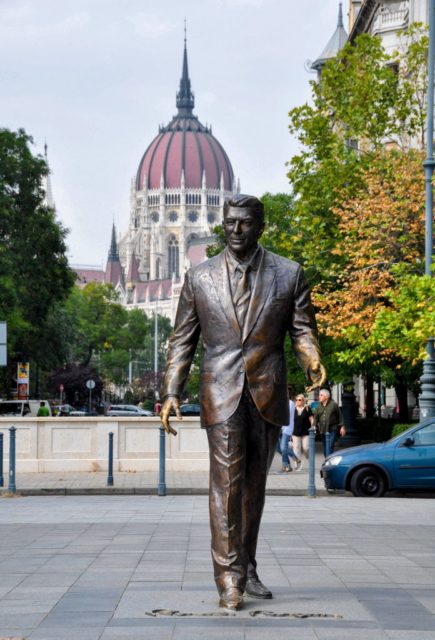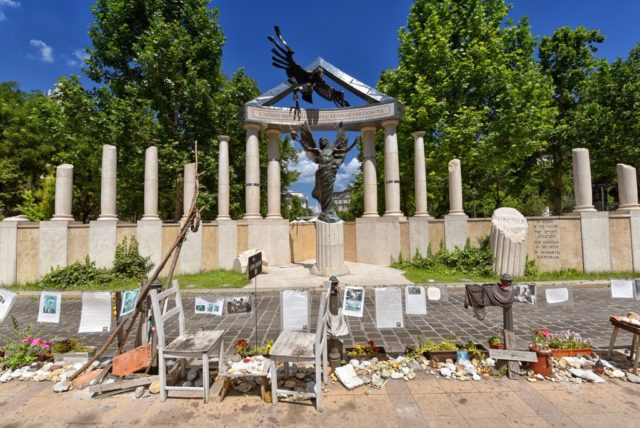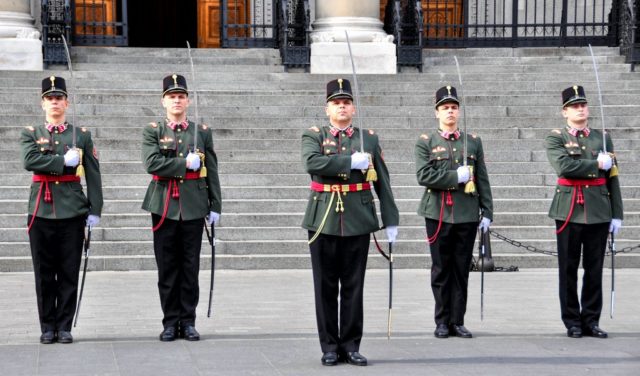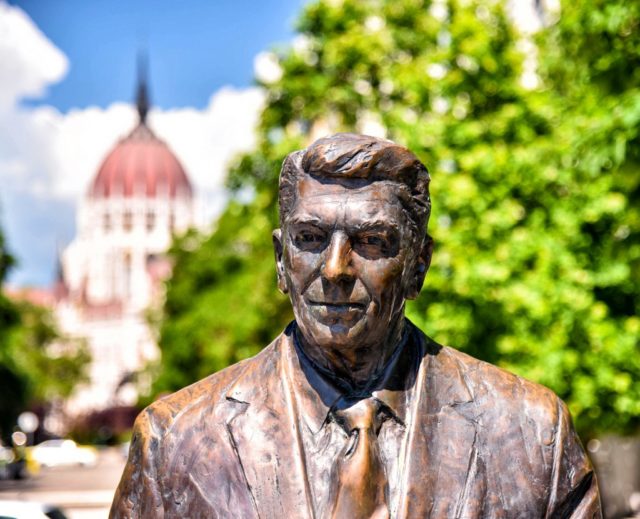You’re walking through Budapest, ogling the grand architecture of Liberty Square, when you bump into someone familiar. That confident stride, that easy smile, that well-coiffed hair: It’s Ronald Reagan. But why on earth is the Gipper hanging out in this prime piece of Hungarian real estate?

The answer is…complicated. But it begins with understanding Hungary’s current ruling party, Fidesz, and its prime minister, Viktor Orbán. Part of travel is learning about the current events of other countries. And over the last few years, Hungary has had one of Europe’s most fascinating political climates.
After Hungary’s previous leadership — the hard-left Social Democrats — immersed the country in debt and humiliating scandals, the political pendulum took a hard swing to the right. In 2010, Viktor Orbán’s party, Fidesz, took power in Hungary. A kindred spirit of Vladimir Putin and Donald Trump, Orbán first came on the scene back in 1989, when — as a long-haired, anti-communist radical — he delivered a rollicking speech in the waning days of communism. As his political career evolved, he moved gradually toward the nationalistic, authoritarian end of the spectrum. During his first term as prime minister, Orbán wore a child’s backpack decorated with soccer players, to drive home his unpretentious, populist affinities. And throughout his career, he has gained rabid supporters in the Hungarian heartland even as he’s horrified big-city progressives and international observers.
Soon after taking power, Fidesz adopted a new constitution that stripped away many checks and balances, and entrenched party leaders in institutions that had previously been considered apolitical. They also nationalized the school system, implementing a Fidesz-friendly curriculum. (Hungarian parents critical of Fidesz equate this to if the US government unilaterally removed all mention of the slave trade, the Trail of Tears, evolution, and climate change from textbooks.) International observers took note when Fidesz created a new FCC-like media authority with sweeping powers — leaving the Hungarian press less free than it once was. Orbán also attempted to levy a per-use tax on all Internet traffic, until tens of thousands of protesters clogged city streets… making it clear Fidesz had gone too far.
If you’ve heard of Viktor Orbán, it was probably in the fall of 2015, when Hungary took a particularly hard line in preventing the flow of Syrian war refugees from entering their country en route to a better life in Western Europe. Orbán erected barbed wire and dispatched an intimidating border defense squad to make it clear that refugees weren’t welcome. While humanitarians condemned Orbán’s actions — which violated the European Union’s open-borders agreements, and left many desperate people with nowhere to go — his supporters tout his success in preventing unwanted refugees from flooding the country.

Fidesz has left their mark all over the Hungarian capital. They went on a renaming binge in Budapest, rechristening streets, squares, and parks to honor patriotic or obscure (but Fidesz-friendly) historical figures. (They even renamed the country: No longer the “Republic of Hungary,” the nation is now formally called, simply, “Hungary.”)

Fidesz also erected a dynamic new monument on Liberty Square, honoring the “Hungarian Victims of Fascism.” While it’s true that many Hungarians died at the hands of the Nazi regime, the monument overlooks the critical fact that Hungary chose to ally with the Nazis early in the war, and that Nazi-empowered Hungarians were some of the worst perpetrators of the Holocaust. As soon as the official monument went up, locals improvised their own memorial directly in front of it — ensuring that the complete history is represented.

In another bold move, for the last couple of years the Parliament has flown two flags: Hungary…and Transylvania. That region (now firmly in Romania) was part of the Hungarian realm for a thousand years. But it was stripped away from Hungary in the Treaty of Trianon that ended World War I. While nationalistic politicians have long used Transylvania (which still has a large Hungarian-speaking minority) as a rallying cry, Fidesz has taken it a step farther: The Transylvanian flag currently occupies the pole that was once reserved for the European Union…making Hungary the only EU member that refuses to fly the EU flag on their capitol.

Up on Castle Hill, overlooking the entire city of Budapest, Orbán has evicted the National Academy of Dance, and is currently renovating their former home to be his personal palace. Critics point out that the Parliament was intentionally built along the riverfront in the city center, to show that the government is one with the people. By moving to the castle — literally looking down on all of Budapest — Orbán is signaling a startlingly different philosophy. (Speculation is that the Royal Palace itself — currently occupied by a pair of museums and some offices — may be next.)

It’s easy to criticize Orbán. But as a traveler who drops in every year or two, I must admit that, from an infrastructure and urban-beautification perspective, Budapest has made great strides in recent years. Under Fidesz, vast swaths of the city have been scrubbed clean, pedestrianized, and landscaped. The formerly ragtag square behind the Parliament has been totally renovated — leaving it sleek, monumental, and (for some) a little too Fascist-feeling. (The brand-new “Changing of the Guard” ceremony — another Fidesz invention — doesn’t do much to reassure them.) The long-delayed green Metró line is finally finished…and it’s slick. And I sense a general pride that I wasn’t aware of 10 years ago. Obviously, the foundations for many of these projects were laid by the previous, left-wing government. And much of the money comes from the EU, which — ironically — Orbán opposes. But the fact remains: A leader with an authoritarian streak gets things done. (I was similarly impressed after a recent visit to Moscow. Say what you will about Putin — and believe me, I know there’s plenty to say — but Moscow is becoming a truly gorgeous city.)

When viewed from a distance, Hungary’s political scene is intriguing…almost entertaining. But for people living there, it’s anything but. On this visit, one of my Hungarian friends — who has two school-age kids —asked me about employment opportunities in Seattle. She feels so depressed at the prospect of raising well-adjusted kids under a regime whose values she can’t stand that she’s considering moving the entire clan abroad until Fidesz is out of power. It reminds me of the pledge that I’ve heard recently from the anti-Trump crowd back home: “If he gets elected, I’m moving to Canada.” (It also made me wonder: There are plenty of tempting “socialist paradise” options for idealistic American lefties to relocate to…Canada, the UK, most of Europe, and so on. But — considering how fundamentally conservative the USA is compared to the rest of the developed world — where do right-wingers move if “things get bad enough”? Well, these days…maybe to Hungary.)

And what about Ronald Reagan? In the early days of Fidesz rule, as Orbán was beginning to take some serious international heat for his questionable policies, he thought it smart to suck up to the powerful USA by erecting a statue of a beloved president in a prime position. And then, perhaps not quite grasping the subtleties of American politics, Orbán invited then-Secretary of State Hillary Clinton to the unveiling.

While Reagan played a role in ending the Cold War, many Hungarian patriots are offended that this monument overshadows the contributions and sacrifices of so many other important, homegrown figures — including Imre Nagy, who was executed for taking a leading role in Hungary’s 1956 Uprising. Just a few steps away from Reagan, a pensive statue of Nagy looks toward the parliament dome. For years, Nagy’s confident gaze struck me as an optimistic sign: Hungary, so long oppressed by communism, was determined to keep an eye on its government to ensure it was moving the country in the right direction. But these days, Nagy looks worried. And, my progressive local friends swear, every time Fidesz passes a bold new reform…Nagy winces.
My husband and I have a photo of us with the Reagan statue, snapped for us by a charming Russian teenager who was vacationing with a group of friends. I then took their photos with the president. We later ran into them in a restaurant I’d recommended they visit. Not to show favoritism, , we also have photos with Nagy on the bridge. We loved our week in Budapest and will visit again in the future.
Cameron: Great synopsis of what is transpiring politically in Hungary. It is particularly disturbing how Orbán and Fidesz are changing the educational system, rewriting history and engaging in anti-science practices. So, if Trump loses in November, perhaps his supporters should consider a 4-year sabbatical in Hungary. They also can worship at the Reagan statue every day.